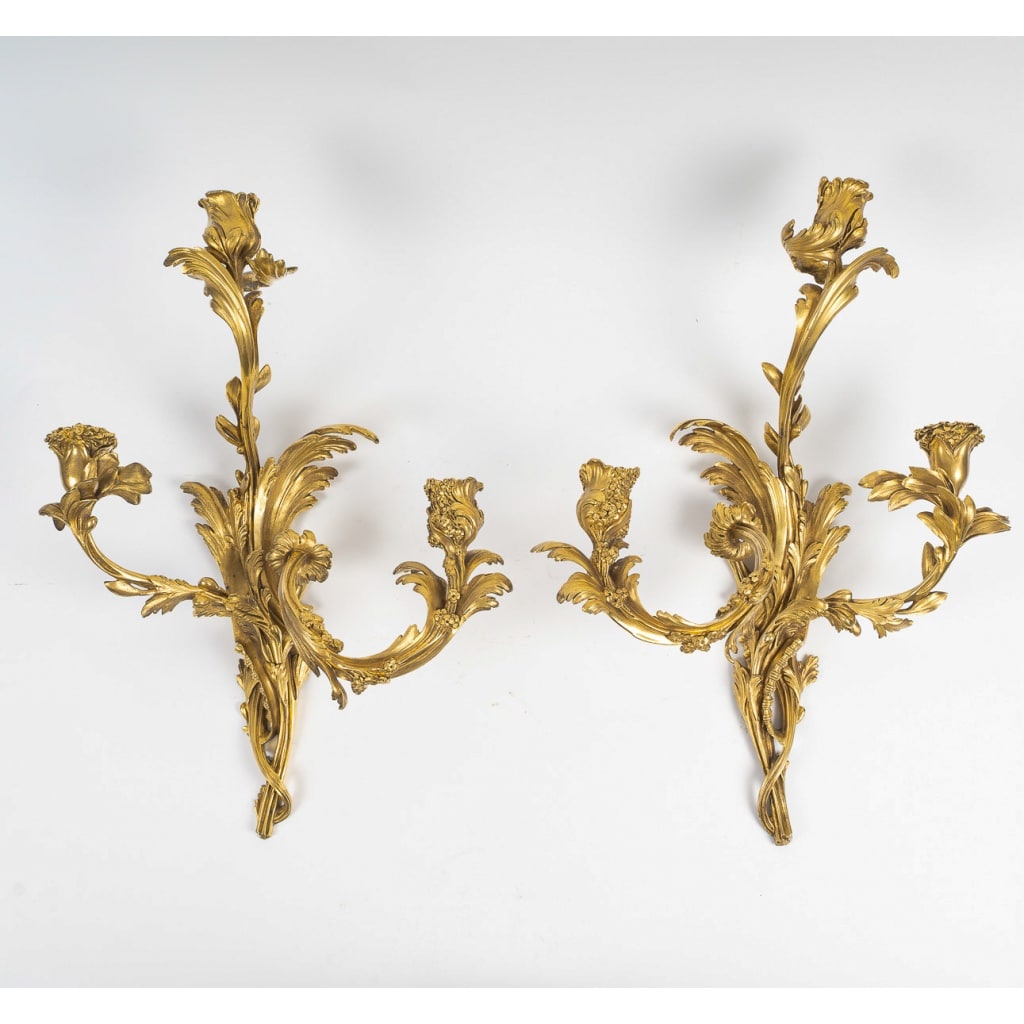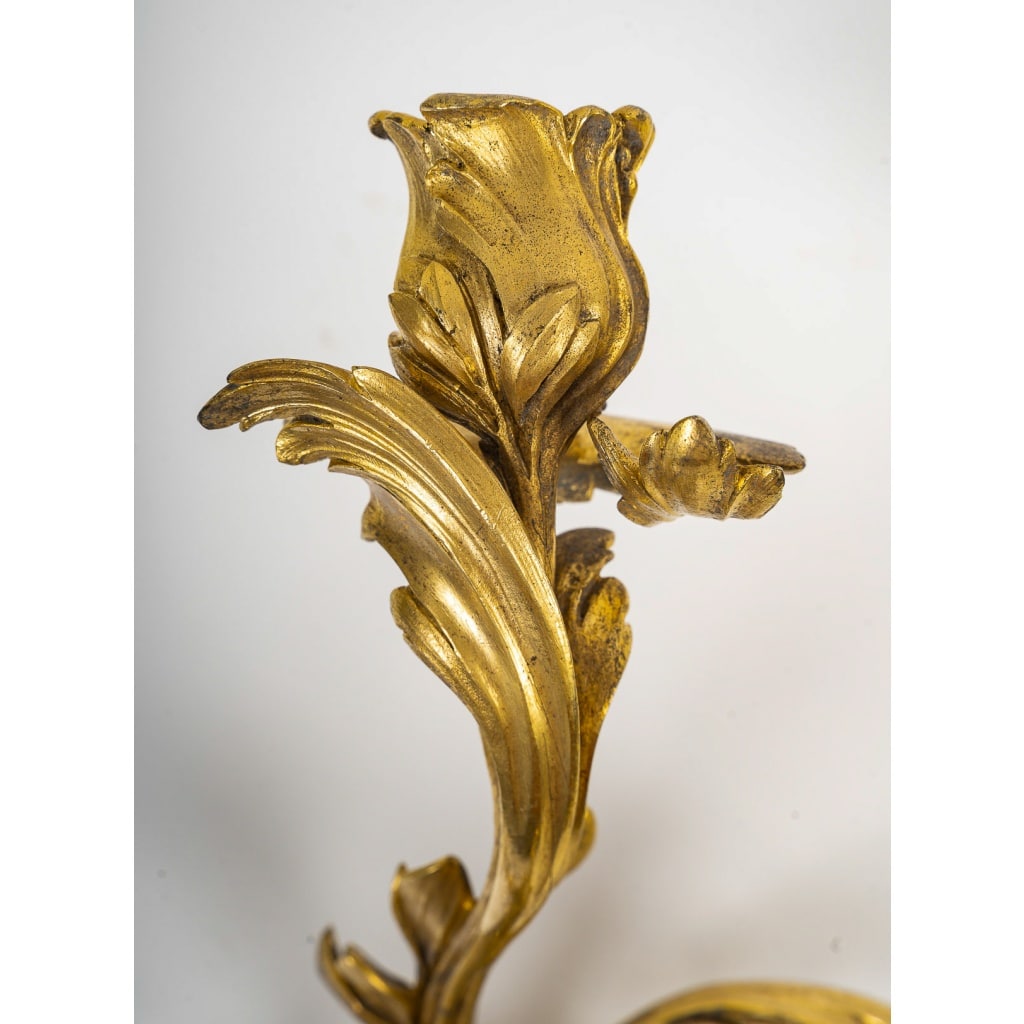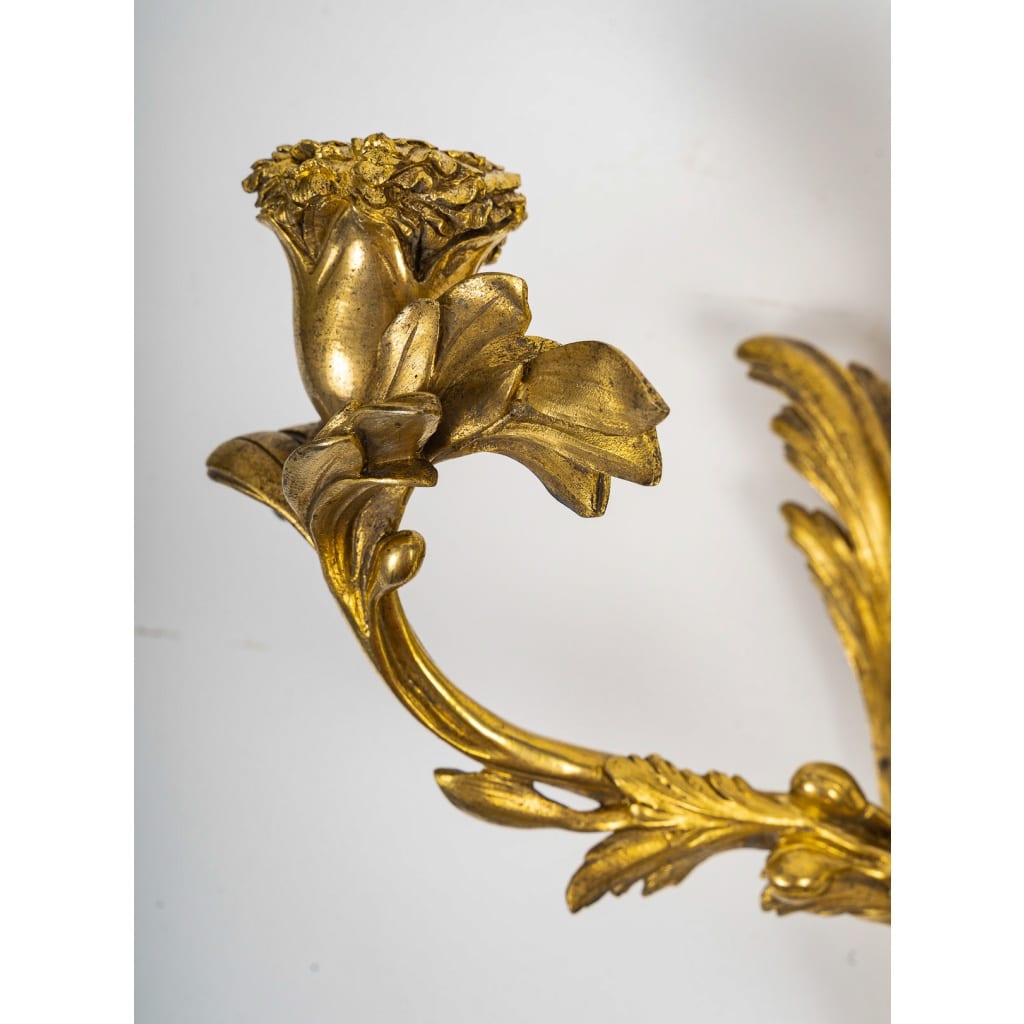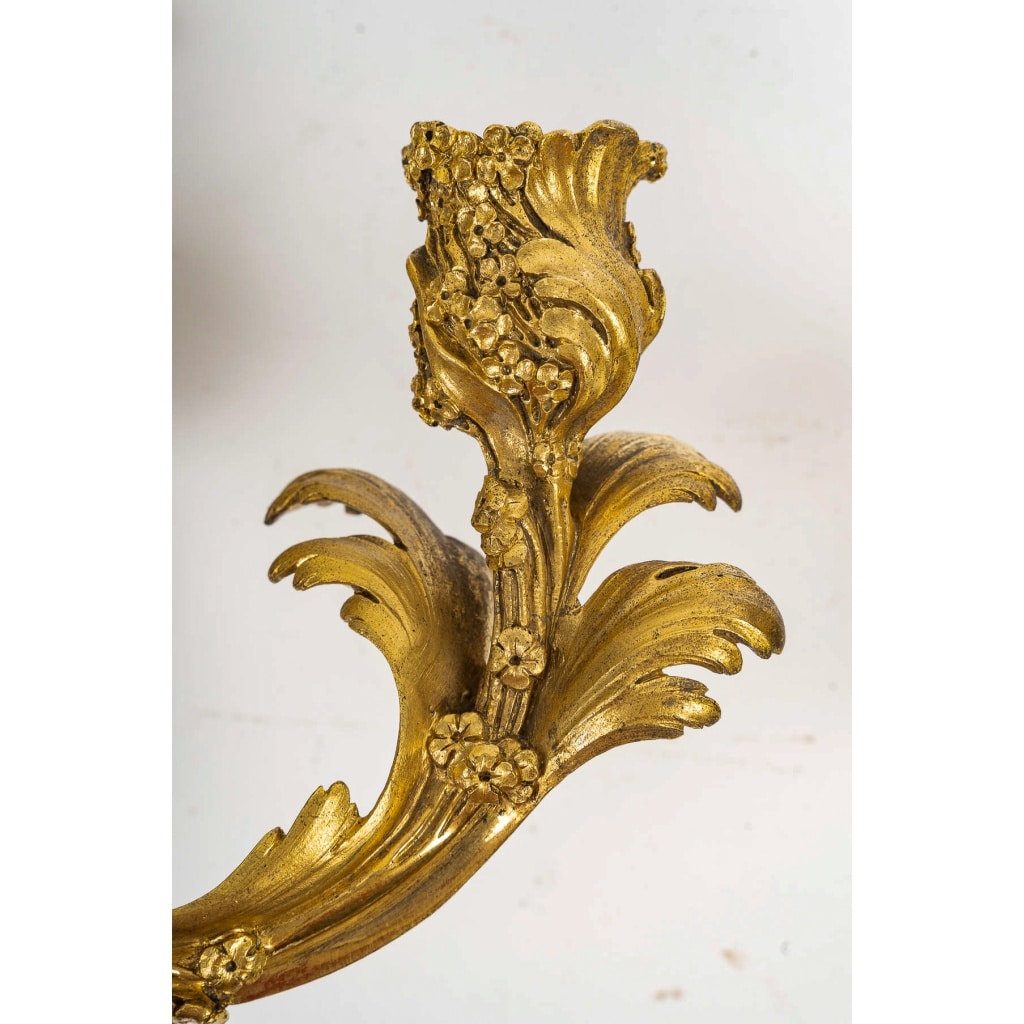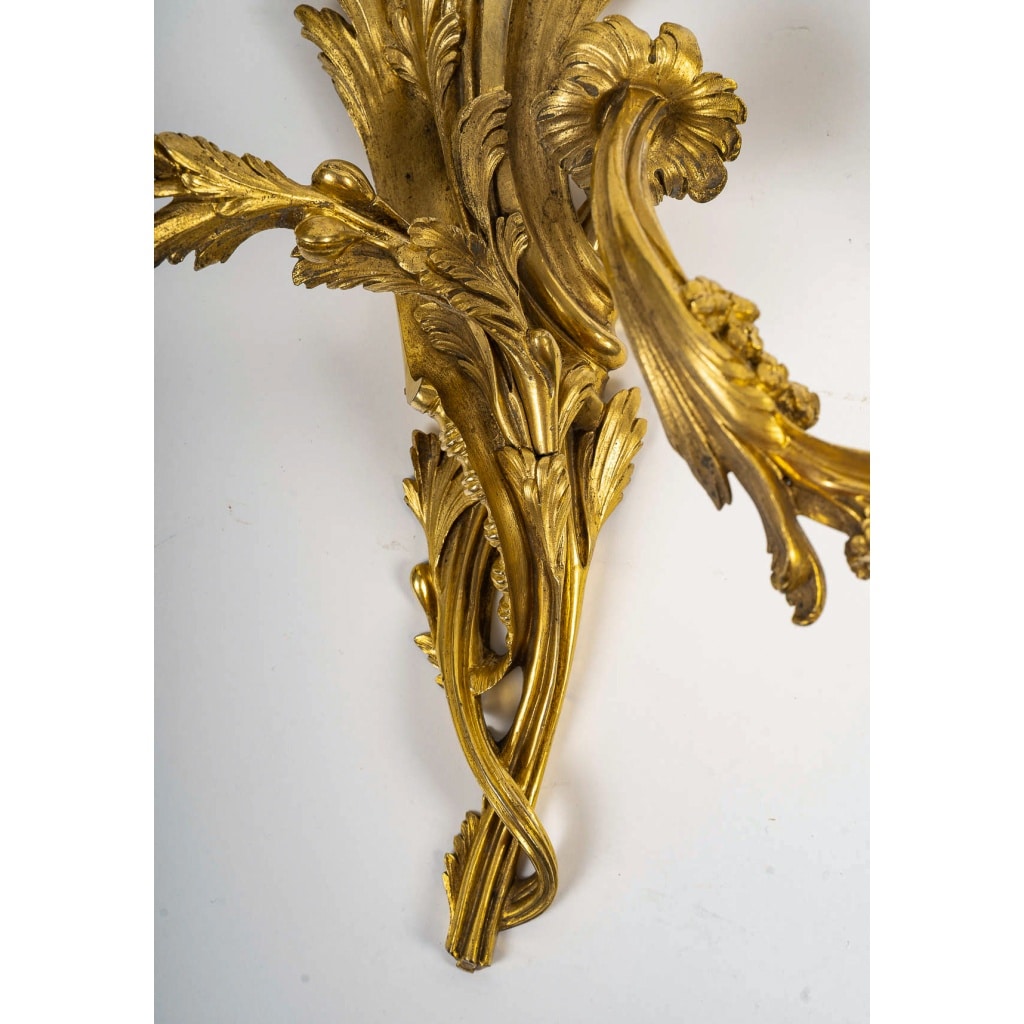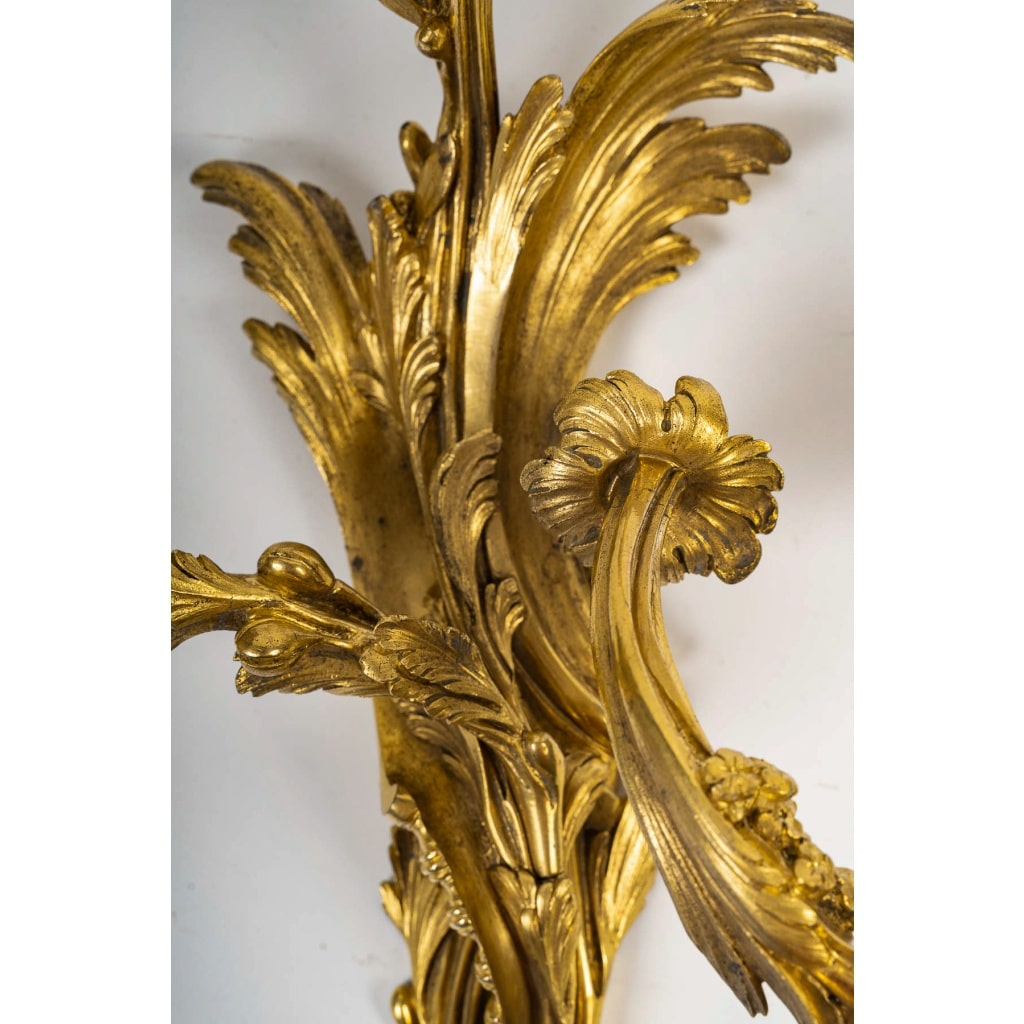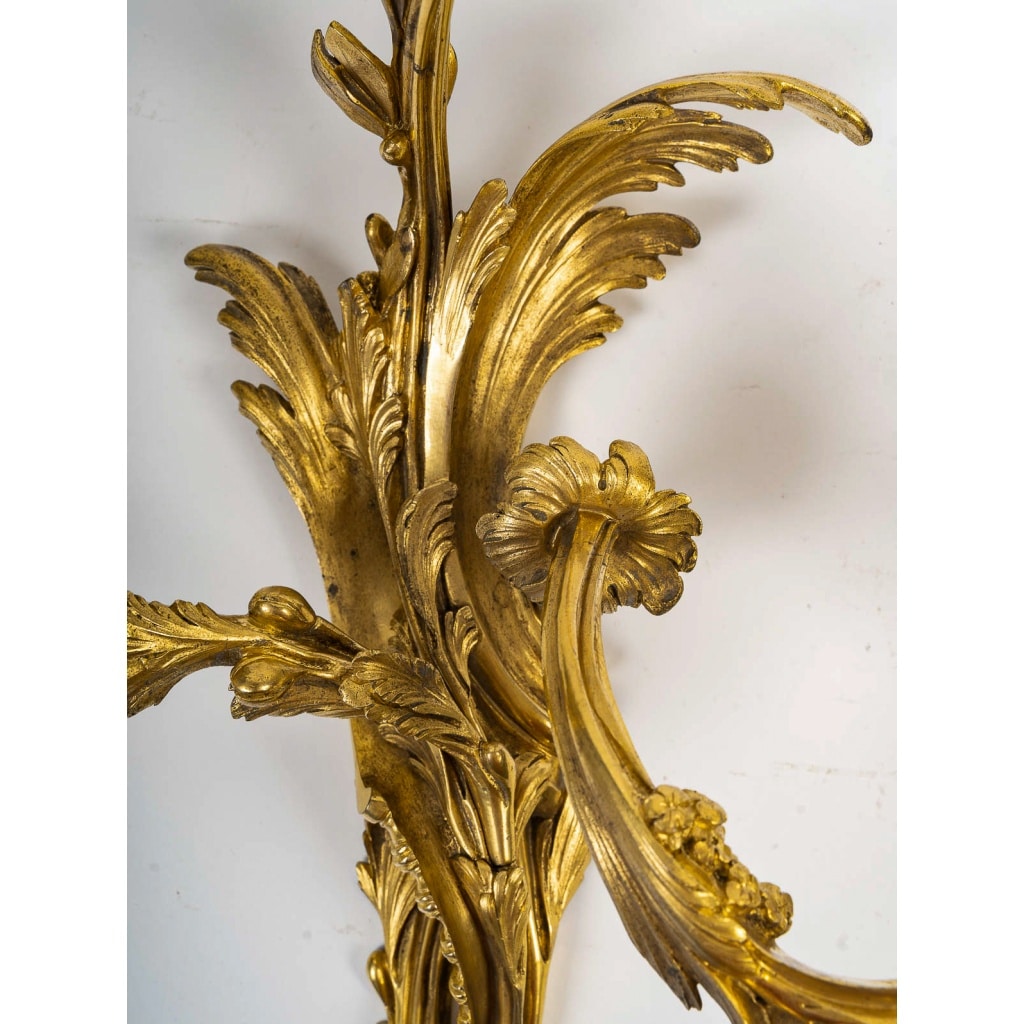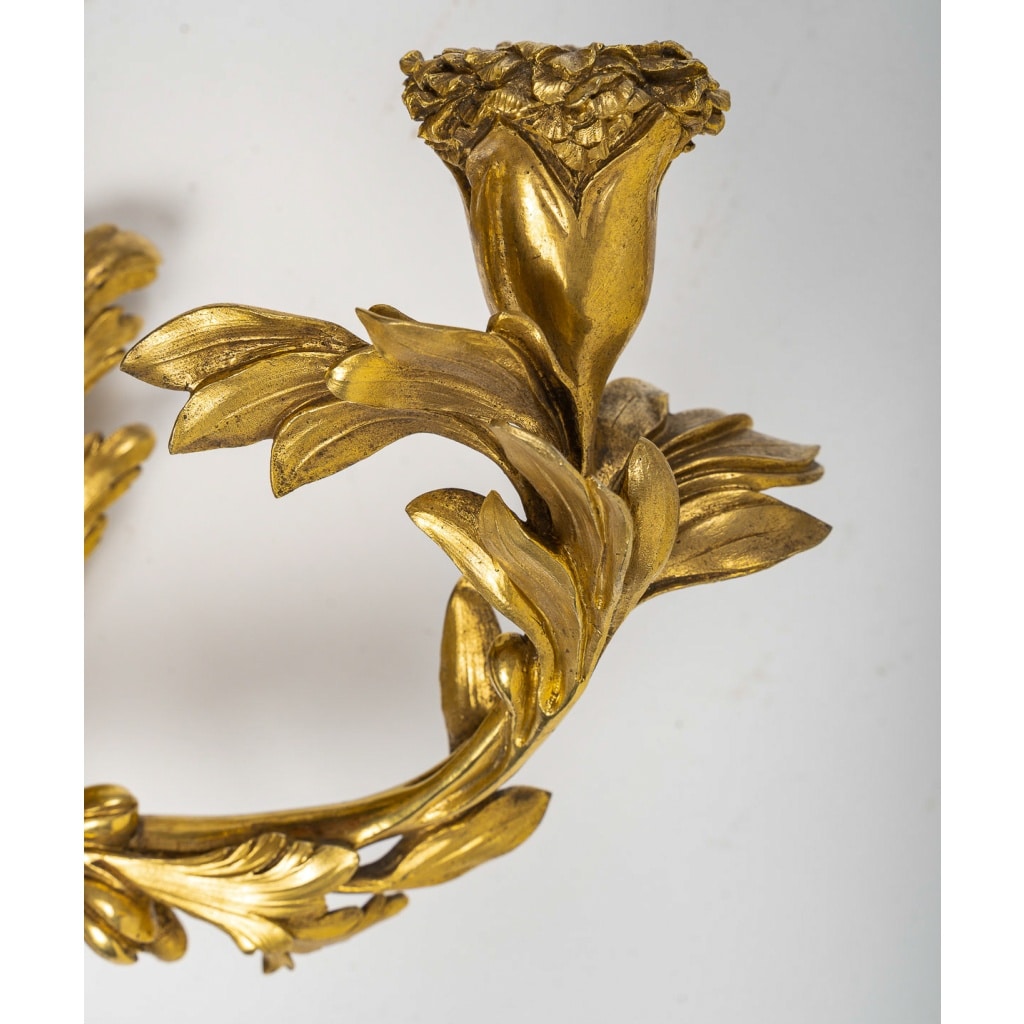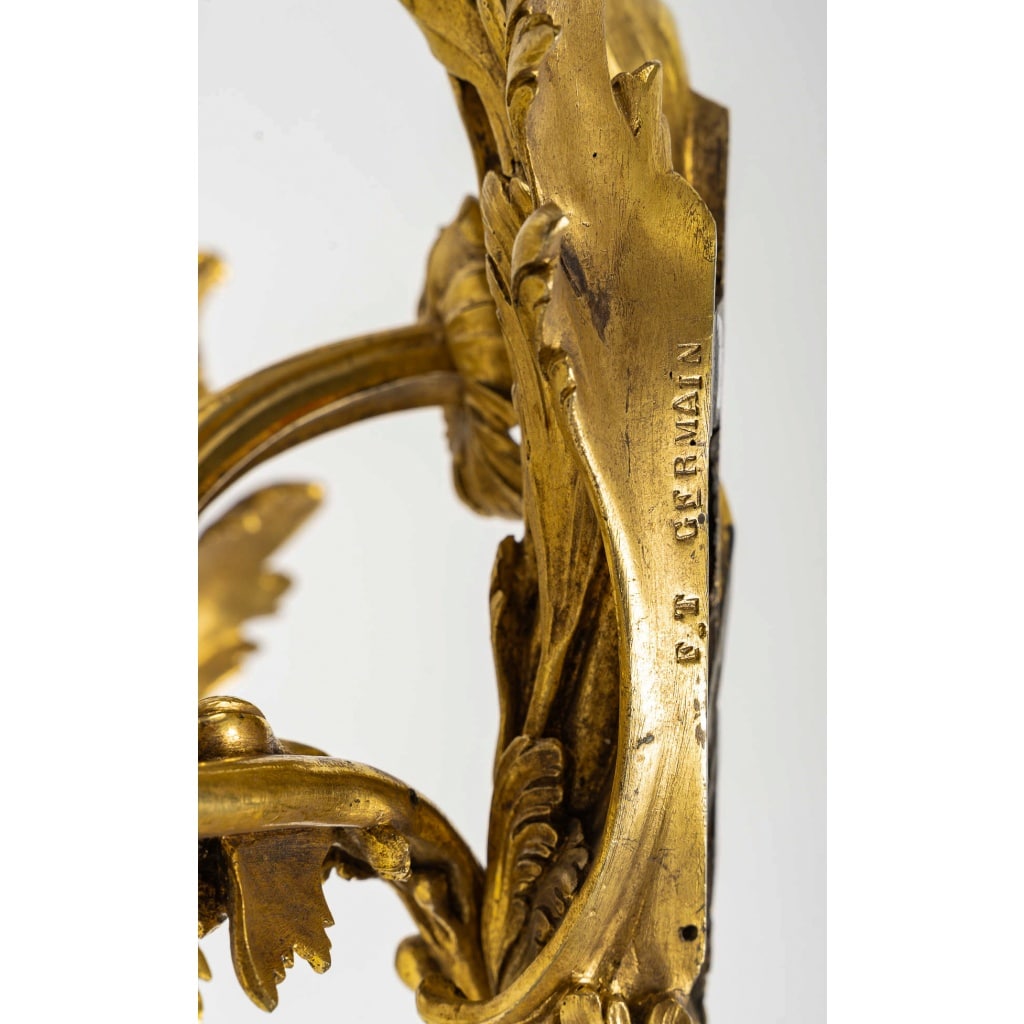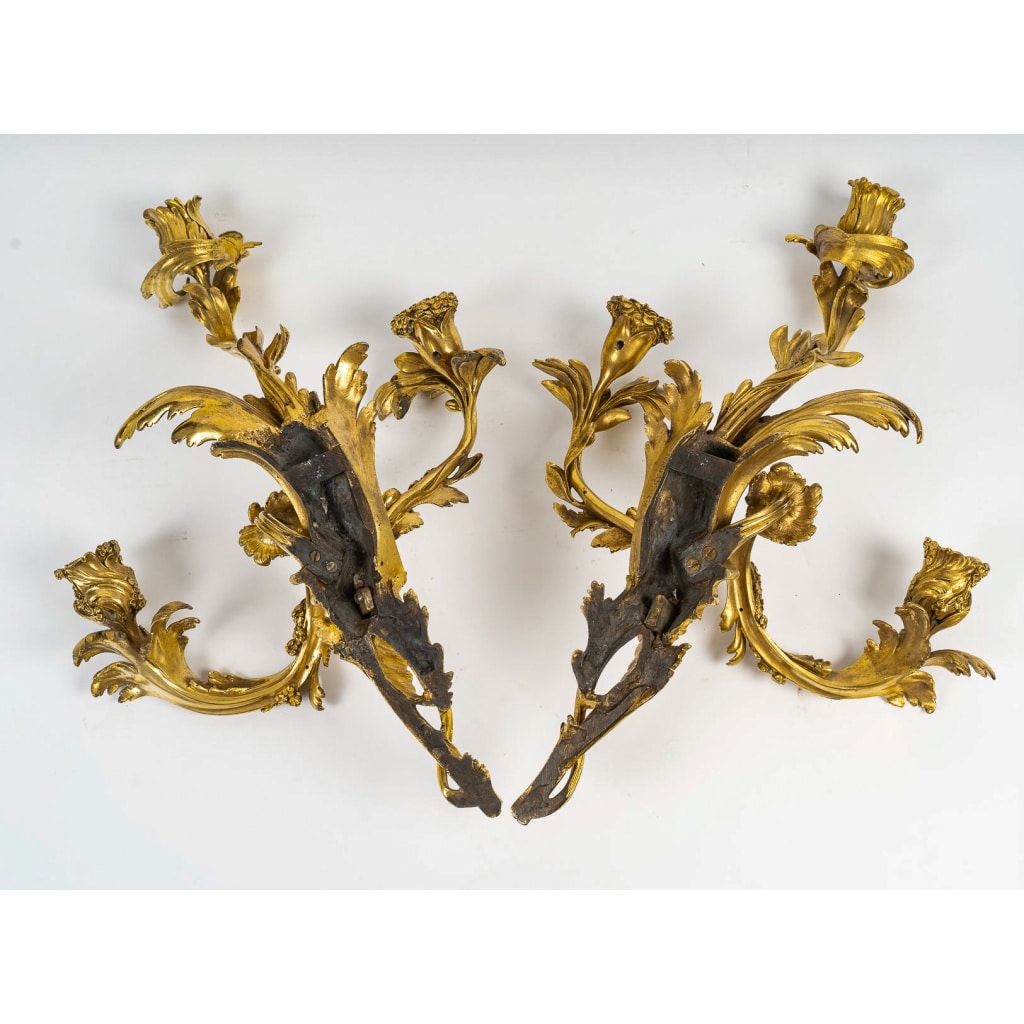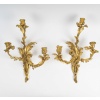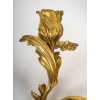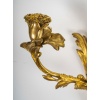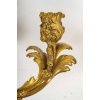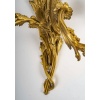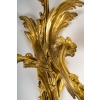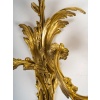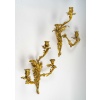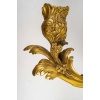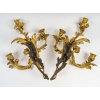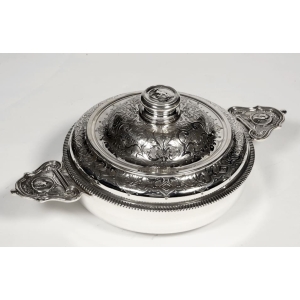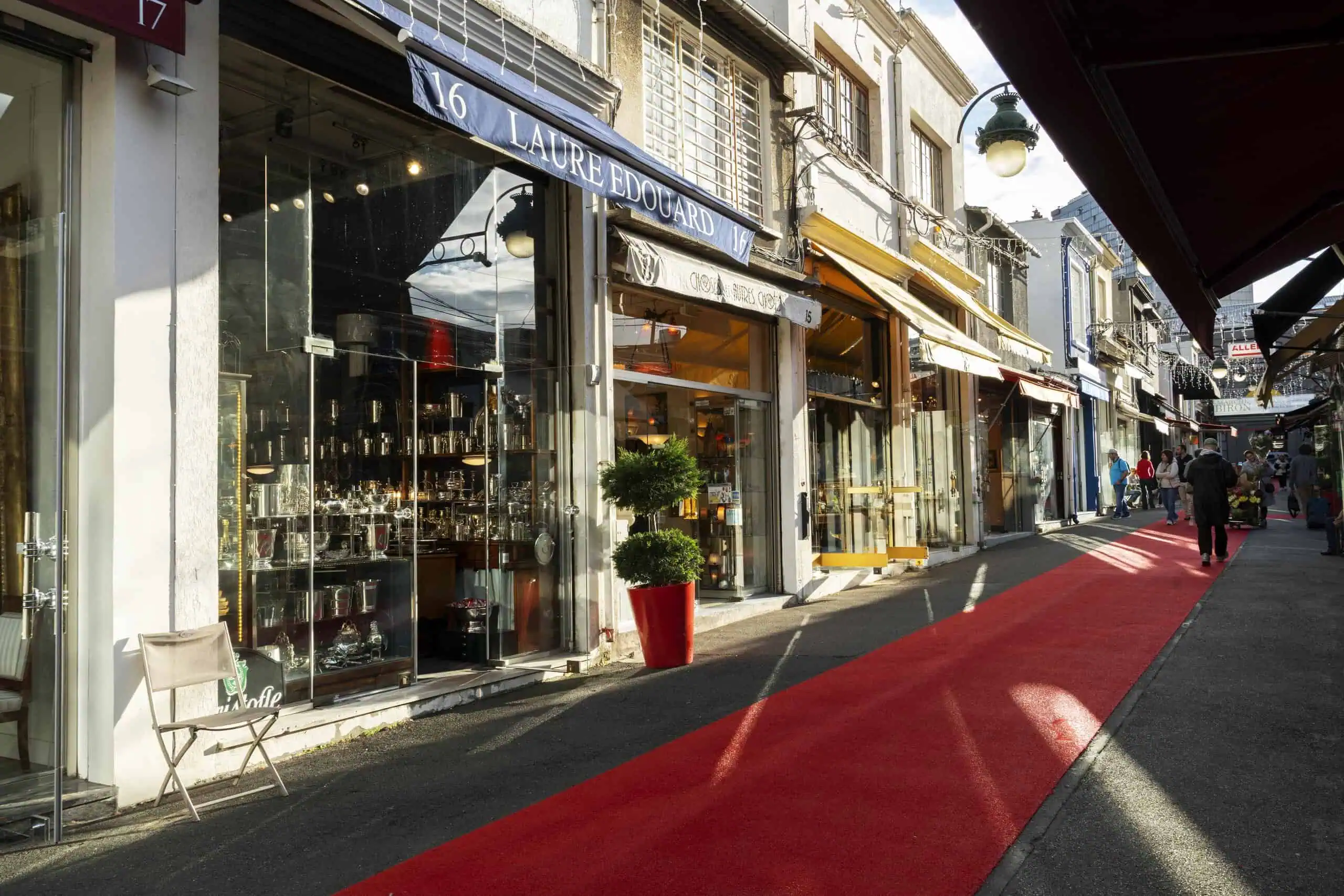François Thomas Germain (1726-1791) Paire d’appliques à trois bras de lumières en bronze ciselé et doré vers 1770-1780
Cette paire d’appliques à trois bras de lumière vers 1770-1780, signée François Thomas Germain, est un chef-d’œuvre de l’artisanat français du XVIIIe siècle, en bronze ciselé et doré, elles incarnent l’élégance et la technicité de l’époque. Comparable aux appliques conservées dans la salle Sully (salle 610 – Marie Leszczynska) du Musée du Louvre, datées elles vers 1740, sous les numéros d’inventaire OA6504-1 et OA6504-2, issues du legs du Comte Isaac de Camondo.
Historiquement importante, une élégante et décorative paire de feux, à trois bras de lumière en bronze finement ciselé, dans une dorure au Mercure préservée. Elles apporteront une touche d’élégance historique à tout intérieur. Elles peuvent être adaptées pour un usage moderne tout en conservant leur charme d’origine.
Nos appliques d’une vraie paire, s’affrontent par leurs trois binets différents dont la ciselure est profonde et élégante.
Un premier binet est en forme de grenade éclatée, le second en enroulement de feuilles et le troisième en fleurs serrées dans des feuillages.
Les platines sont en forme de faisceaux de tiges et de feuilles portant les bras de lumière qui eux aussi reproduisent des branches portant des bourgeons et des fleurs.
Une des deux appliques de cette paire est signée par François Thomas Germain, un des plus grands orfèvres du XVIIIème siècle français. En l’état de nos connaissances, la signature est certainement celle utilisée après 1765, après avoir perdu le titre d’orfèvre ordinaire du Roy.
Ces appliques concentrent toute la technicité, l’inventivité et la modernité dont savait faire preuve François Thomas Germain.
Les binets sont fondus d’une seule pièce avec les bras tout en émergeant de feuillages, ce riche travail dénote une complexité de fonte du bronze.
C’est clairement une prouesse technique pour l’époque, où il était beaucoup plus facile de fondre par petits morceaux les éléments formant ce type d’objet. Les bras de lumière sont d’un seul bloc et par la suite ciselé dans la masse.
L’atelier de François Thomas Germain est un des plus important pour l’époque, peut-être plus de 150 artisans collaborateurs y travaillaient. Il sera le précurseur dans la conception des grands ateliers du XIXème siècle.
Le revers de la médaille de ce géant pour l’époque, est que le Maitre Orfèvre, n’exécute plus lui-même les pièces. Il se contente souvent de n’apposer que son Fer. L’atelier travaillait sur la fin dans l’urgence, d’où parfois un petit manque de qualité dans les ciselures.
Magnifique travail Français du XVIIIème siècle vers 1770-1780, dans le plus classique style Rocaille florale.
Dimensions : Hauteur 48 cm – Largeur 36 cm – Profondeur 20 cm.
En très bon état de conservation, dans une belle dorure au Mercure préservée.
Nous signalons que les appliques ont été anciennement percées pour une électrification. Possibilité d’électrification sur demande.
Biographie :
François-Thomas Germain (1726-1791).
François-Thomas Germain, né à Paris le 18 avril 1726 et décédé dans la même ville le 23 janvier 1791, est un orfèvre français renommé. Fils de Thomas Germain, surnommé « l’artiste à la main divine », François-Thomas a hérité de la réputation de son père tout en se forgeant la sienne propre, marquée par un talent exceptionnel et une carrière tumultueuse.
Formation et Débuts :
Dès son plus jeune âge, François-Thomas Germain fut immergé dans l’univers de l’orfèvrerie, observant les travaux réalisés dans l’atelier du Louvre où officiait son père. Avant de lui transmettre les outils, Thomas Germain insista pour que son fils apprenne à dessiner et l’envoya à l’Académie royale de peinture.
Carrière et Réalisations :
– Sculpteur Orfèvre du Roi : En 1748, François-Thomas fut nommé sculpteur orfèvre du roi, succédant à son père et obtenant un logement au Louvre.
– Héritage Artistique : À la mort de son père, il hérita d’une précieuse collection de dessins et de modèles, qu’il utilisa tout au long de sa carrière.
– Reconnaissance Royale : En 1751, il fut reçu comme orfèvre ordinaire du roi, associé à Jacques Roettiers, consolidant ainsi sa position dans le milieu artistique.
Expansion et Déclin :
François-Thomas Germain développa ses ateliers à une échelle industrielle, commerçant avec toute l’Europe. Cependant, ses dépenses extravagantes et son train de vie luxueux le menèrent à la faillite en 1765. Cette situation lui fit perdre son titre d’orfèvre ordinaire du roi, mais il continua d’exercer son métier, collaborant notamment avec son confrère Dapcher, rue de La Vannerie.
Héritage :
Malgré ses revers financiers, François-Thomas Germain reste une figure marquante de l’orfèvrerie française du XVIIIe siècle. Ses œuvres témoignent de son talent et de son héritage artistique, perpétuant le nom des Germain dans l’histoire de l’art.
François Thomas Germain (1726-1791) Pair of Three-Arm Bronze Wall Sconces, circa 1770-1780
This pair of three-arm wall sconces circa 1770-1780, signed by François Thomas Germain, is a masterpiece of 18th-century French craftsmanship. Crafted in chiseled ormolu, they embody the elegance and technical prowess of the era. Comparable to the sconces kept in The Louvre Museum in the Sully Room (Room 610 – Marie Leszczynska), dated around 1740, under inventory numbers OA6504-1 and OA6504-2, from the bequest of Count Isaac de Camondo.
An historical important, elegant, and decorative pair of sconces, with three arms of light in finely chiseled bronze, featuring preserved mercury gilding. They will bring a touch of historical elegance to any interior and can be adapted for modern use while retaining their original charm.
Our sconces, a true pair, stand out with their three distinct bobeches, each featuring deep and elegant chiseling. One bobeche is shaped like an exploding pomegranate, the second with a leaf scroll, and the third with flowers nestled in foliage. The backplates are shaped like bundles of stems and leaves, supporting the light arms, which also replicate branches bearing buds and flowers. One of the two sconces in this pair is signed by François Thomas Germain, one of the greatest goldsmiths of 18th-century France. To the best of our knowledge, the signature is likely the one used after 1765, following the loss of the title of ordinary goldsmith to the King.
These sconces embody all the technical skills, inventiveness, and modernity that François Thomas Germain was known for. The bobeches are cast in one piece with the arms, emerging from foliage, demonstrating a complex bronze casting technique. This was clearly a technical feat for the time, as it was much easier to cast such objects in smaller pieces. The light arms are made from a single block and subsequently chiseled from the mass.
François Thomas Germain’s workshop was one of the most significant of its time, with perhaps more than 150 collaborating craftsmen. He was a pioneer in the design of large workshops of the 19th century. The downside of this giant of the era was that the Master Goldsmith no longer executed the pieces himself. He often merely affixed his stamp. The workshop, towards the end, worked in haste, sometimes resulting in minor quality issues in the chiseling.
A magnificent example of French 18th-century era work, circa 1780, in the classic Rocaille style.
Dimensions: Height 18.89 Inches – Width 14.17 Inches – Depth 7.87 Inches.
In very good condition, with preserved mercury gilding. We note that the sconces were previously drilled for electrification.
Biography:
François-Thomas Germain (1726-1791).
François-Thomas Germain, born in Paris on April 18, 1726, and died in the same city on January 23, 1791, was a renowned French goldsmith. The son of Thomas Germain, known as the « artist with the divine hand, » François-Thomas inherited his father’s reputation while forging his own, marked by exceptional talent and a tumultuous career.
Education and Early Years:
From a young age, François-Thomas Germain was immersed in the world of goldsmithing, observing the work carried out in his father’s workshop at the Louvre. Before handing him the tools, Thomas Germain insisted that his son learn to draw and sent him to the Royal Academy of Painting.
Career and Achievements:
– Royal Sculptor Goldsmith: In 1748, François-Thomas was appointed as the royal sculptor goldsmith, succeeding his father and securing lodging at the Louvre.
– Artistic Legacy: Upon his father’s death, he inherited a valuable collection of drawings and models, which he used throughout his career.
– Royal Recognition: In 1751, he was received as an ordinary goldsmith to the king, in association with Jacques Roettiers, thus consolidating his position in the artistic community.
Expansion and Decline:
François-Thomas Germain expanded his workshops to an industrial scale, trading with all of Europe. However, his extravagant spending and luxurious lifestyle led to bankruptcy in 1765. This situation caused him to lose his title as the ordinary goldsmith to the king, but he continued to practice his craft, collaborating with his colleague Dapcher on Rue de la Vannerie.
Legacy:
Despite his financial setbacks, François-Thomas Germain remains a significant figure in 18th-century French goldsmithing. His works testify to his talent and artistic legacy, perpetuating the Germain name in art history.

